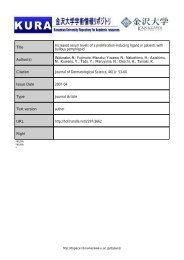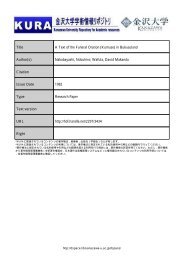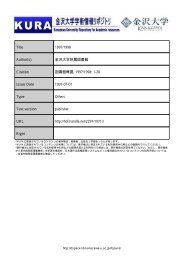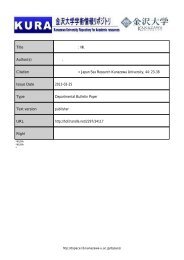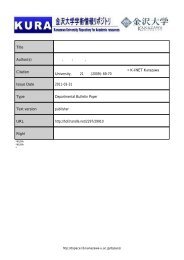Title The Study on Myanmar trade ware:Martaban Jar and ... - 金沢大学
Title The Study on Myanmar trade ware:Martaban Jar and ... - 金沢大学
Title The Study on Myanmar trade ware:Martaban Jar and ... - 金沢大学
Create successful ePaper yourself
Turn your PDF publications into a flip-book with our unique Google optimized e-Paper software.
<strong>金沢大学</strong>考古学紀要 30 2009, 101-136. <str<strong>on</strong>g>The</str<strong>on</strong>g> study of <strong>Myanmar</strong> <strong>trade</strong> <strong>ware</strong> : <strong>Martaban</strong> jar <strong>and</strong> white dish<br />
4.2 <strong>Myanmar</strong> opaque white <strong>ware</strong> unearthed from Japan<br />
<strong>Myanmar</strong> opaque white <strong>ware</strong> is rarely found in comparis<strong>on</strong><br />
with black glazed <strong>ware</strong> or <strong>Martaban</strong> jar from the excavati<strong>on</strong><br />
of archaeological sites in Japan. <str<strong>on</strong>g>The</str<strong>on</strong>g> excavati<strong>on</strong> of Sakaikangotoshi<br />
site in 1996 yielded a few glazed sherds from three<br />
dishes. And another <strong>on</strong>e opaque white dish was unearthed from<br />
Hirado-Dutch Mercantile House site located in Hirado city,<br />
Nagasaki prefecture in 1988. <strong>Myanmar</strong> opaque white dishes<br />
unearthed from these both sites are the same characteristic with<br />
similar type <strong>and</strong> size comm<strong>on</strong>ly.<br />
4.2-1 Opaque white <strong>ware</strong> from Sakai-kangotoshi site<br />
Sakai-kangotoshi site lies at the northwest of Sakai city, <strong>and</strong><br />
it was known as the city site from medieval period to recent<br />
modern period. <str<strong>on</strong>g>The</str<strong>on</strong>g> layers (top most layer, level 1 <strong>and</strong> level 2)<br />
with 80cm thickness from the top most layer to the below are<br />
from the recent period to modern time. <str<strong>on</strong>g>The</str<strong>on</strong>g> cultural layers are<br />
from the level 3 to level 5.Burnt soil layers are found at below of<br />
almost levels. <str<strong>on</strong>g>The</str<strong>on</strong>g> Southeast Asian imported ceramics of Thai,<br />
Vietnam <strong>and</strong> <strong>Myanmar</strong> were unearthed together with Chinese<br />
<strong>and</strong> Hizen ceramic of local Japanese <strong>ware</strong>s from level 3.Four<br />
fragments of <strong>Myanmar</strong> opaque <strong>ware</strong> were excavated. Am<strong>on</strong>g<br />
these sherds, <strong>on</strong>e is perfect big shed from the part of mouth to<br />
foot-rim, <strong>and</strong> also found another <strong>on</strong>e of its company. <str<strong>on</strong>g>The</str<strong>on</strong>g> other<br />
two sherds are mouth parts from two dishes. C<strong>on</strong>flagrati<strong>on</strong> had<br />
made <strong>on</strong>e sherd to become black colour <strong>on</strong> some parts <strong>and</strong> also<br />
the fabric colour to become dark gray. <str<strong>on</strong>g>The</str<strong>on</strong>g>re are black colour<br />
grains found inside fabric clearly. However, the original fabric<br />
colour would be red in colour. <str<strong>on</strong>g>The</str<strong>on</strong>g>se dishes are comm<strong>on</strong>ly with<br />
nearly same sizes. Opaque white glaze was applied <strong>on</strong> both of<br />
interior <strong>and</strong> exterior parts until foot-ring.<br />
Sakai.MM-1 (Fig.19.a): <str<strong>on</strong>g>The</str<strong>on</strong>g> straight mouth of the dish is<br />
tapering from the thick base to the nearly pointed end of mouthrim<br />
by shaving from both sides. Both sides of foot-rim were also<br />
shaved. <str<strong>on</strong>g>The</str<strong>on</strong>g> firing support mark with 9.5cm in diameter is found<br />
at the base surface of inside foot-ring. <str<strong>on</strong>g>The</str<strong>on</strong>g> diameter of mouth is<br />
26.2cm <strong>and</strong> the base is 18.7cm with 5.5cm in height. <str<strong>on</strong>g>The</str<strong>on</strong>g> fabric<br />
colour is red <strong>and</strong> a small part is with gray. Reddish brown colour<br />
grains are mixing inside the fabric. <str<strong>on</strong>g>The</str<strong>on</strong>g> incised lines found<br />
around the foot-ring show that its foot-ring was shaped by using<br />
some pointed tools. It is without decorated design however the<br />
two sink-line circles are at the interior surface of the dish.<br />
Sakai.MM-2 (Fig.19.b): <str<strong>on</strong>g>The</str<strong>on</strong>g> straight mouth of the dish is also<br />
gradually tapering to the rounded mouth-rim. In this dish, the<br />
two horiz<strong>on</strong>tal incised lines are found nearly below the mouthrim<br />
at the exterior part. <str<strong>on</strong>g>The</str<strong>on</strong>g> mouth diameter would be about<br />
27cm <strong>and</strong> its remnant height is 4.6cm. Opaque white colour<br />
glaze was applied <strong>on</strong> both of interior <strong>and</strong> exterior part. However<br />
− 118 −<br />
some part became black colour <strong>and</strong> the fabric is dark gray<br />
colour because of the c<strong>on</strong>flagrati<strong>on</strong>. <str<strong>on</strong>g>The</str<strong>on</strong>g> original fabric would<br />
be reddish gray in colour mixing dark reddish brown colour<br />
grains inside fabric.<br />
Sakai.MM-3 (Fig.19.c): <str<strong>on</strong>g>The</str<strong>on</strong>g> dish is also with tapering straight<br />
mouth, however the interior part of mouth--rim is more shaved<br />
with rounded curve than the exterior part. <str<strong>on</strong>g>The</str<strong>on</strong>g> mouth diameter<br />
would be 27cm <strong>and</strong> it remnant is 2.6cm in height. Opaque white<br />
glaze was applied <strong>on</strong> both parts. <str<strong>on</strong>g>The</str<strong>on</strong>g> inside of reddish gray<br />
colour fabric is mixing with reddish brown colour grains.<br />
4.2-2 Opaque white <strong>ware</strong> from Hirado<br />
Hirado-Dutch mercantile house was firstly found in 1609 in<br />
Japan. It is an important archaeological site for foreigners <strong>and</strong><br />
also a valuable historic site for Japan. Hirado City Board of<br />
Educati<strong>on</strong> excavated the site of Hirado-Dutch mercantile house<br />
for seven times from 1987 (Showa 62) to 1998 (Heisei 10).<br />
<strong>Myanmar</strong> opaque white glazed dish was unearthed from the<br />
boundary wall of Hirado Dutch mercantile house together<br />
with other <strong>trade</strong> ceramics. Its size <strong>and</strong> feature are the same as<br />
<strong>Myanmar</strong> opaque white dish found in Sakai-kangotoshi site.<br />
<str<strong>on</strong>g>The</str<strong>on</strong>g> dish is nearly the same size as the dish unearthed from<br />
Sakai site. <str<strong>on</strong>g>The</str<strong>on</strong>g> straight mouth is gradually tapering from the<br />
thick base to the mouth-rim. <str<strong>on</strong>g>The</str<strong>on</strong>g> foot-ring is also shaped by<br />
using some pointed tool, <strong>and</strong> both parts of foot-rim <strong>on</strong> the<br />
interior <strong>and</strong> exterior were shaved inequitably. <str<strong>on</strong>g>The</str<strong>on</strong>g> mouth<br />
diameter is 26.7cm, its base is 18.8cm <strong>and</strong> the height is 5.5cm.<br />
<str<strong>on</strong>g>The</str<strong>on</strong>g> fabric is red colour <strong>and</strong> mixing small reddish brown grains.<br />
<str<strong>on</strong>g>The</str<strong>on</strong>g> two sink-circle lines are <strong>on</strong> the interior surface <strong>and</strong> it is very<br />
similar to the dish of Sakai.MM-1.(Figu. 20)<br />
4.3 <strong>Myanmar</strong> white dish unearthed from Ind<strong>on</strong>esia<br />
(Figure21)<br />
Some glazed sherds of <strong>Myanmar</strong> opaque white dishes together<br />
with black glazed sherds of <strong>Martaban</strong> jars were unearthed from<br />
the site of Wolio castle ruins,Butan Isl<strong>and</strong>, Southeast Sulawesi<br />
in Ind<strong>on</strong>esia. <str<strong>on</strong>g>The</str<strong>on</strong>g>re found that opaque white glaze was applied<br />
<strong>on</strong> the interior until the foot-rim at the exterior. Its the fabric<br />
coulor is red. A glazed sherd of mouth part is folded mouth. <str<strong>on</strong>g>The</str<strong>on</strong>g><br />
same type of white dish was comm<strong>on</strong>ly found in Twante canal<br />
site, Lower <strong>Myanmar</strong>. Although these finds are reliable sources<br />
to date the age of <strong>Myanmar</strong> <strong>trade</strong> ceramics, it is not inserted<br />
in the group of classificati<strong>on</strong> in my research because I did not<br />
directly c<strong>on</strong>duct this research by myself. <str<strong>on</strong>g>The</str<strong>on</strong>g> discovery of Wolio<br />
castle site indicates that white dish of <strong>Myanmar</strong> ceramics <strong>and</strong><br />
<strong>Martaban</strong> jars were <strong>trade</strong>d to Ind<strong>on</strong>esia at the same time around<br />
16th <strong>and</strong> 17th century.




